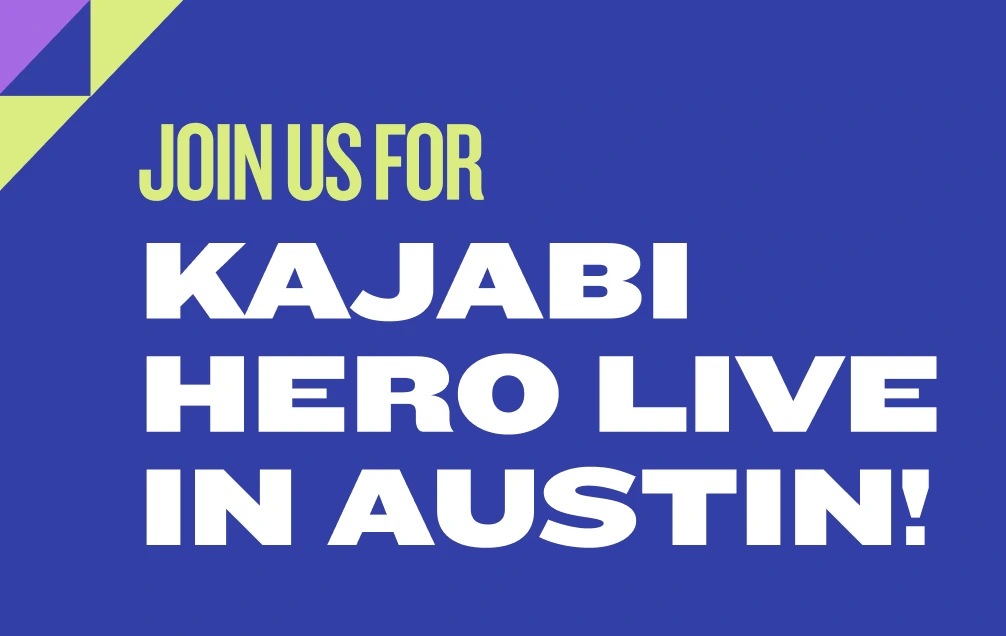
What are cohort based courses and why should you offer them?
Get free expert insights and tips to grow your knowledge business sent right to your inbox.
As a coach, your reputation depends on a high success rate — especially if your offer is transformational, as with life coaching, nutrition coaching, or financial coaching.
Deliver your coaching the wrong way, though, and you’ll struggle to deliver the success you promise.
For the last decade, coaches have focused on self-paced courses as a way to help people at scale. But today, they’re realizing that the self-paced format is giving them a dismal completion rate: just 5-15%. Simply by shifting their training to cohort-based coaching, they’re seeing a massive boost in student success.
What are cohort-based courses? How can they benefit you and your students? That’s what you’ll learn in this article.
What is cohort learning?
Cohort learning is an instructional format where a group of students advance through a course or coaching program together.
Think back to your school days. You and your classmates started on the same day and graduated on the same day. You studied the same lessons and worked on the same assignments, all at the same times. That’s how cohort learning works. You and your classmates were in a cohort.
But cohort learning isn’t restricted to the schoolroom. It’s an effective format for digital courses, coaching programs, and online teaching.
Take The Wealth Transfer Investing Course, taught by Dominique Broadway of Finances Demystified.
Dominique offers step-by-step lessons and guidebooks, similar to a traditional, self-paced course. But her program is delivered through live training, and she offers a Discord group that provides accountability, so her students are more likely to complete the course and achieve their goals.
Each time she launches the course, she forms a new cohort group. That group gets to know one another and support one another throughout the training.
Notice that on the sales page, Dominique includes a timer, counting down the days and hours until her next cohort group begins. Students can enroll until the timer zeroes out.

And it works. Dominique’s students aren’t just succeeding, they’re singing her praises. Here are a few of her student testimonials:

The benefits of cohort-based courses
Why does cohort learning work so well? Here are some of the biggest benefits of this style of teaching.
A higher success rate. As we’ve already mentioned, the biggest benefit of cohort-based courses is its success rate. While self-paced courses have a paltry 5-15% completion rate, cohort-based courses have a 70% completion rate.
Students inherently know this. They’ve taken enough self-directed courses to know they’re likely to get stuck. No matter how excited they are to start the course, they’re unlikely to finish.
A cohort-based course helps them stay engaged. They can ask questions and get answers. If they feel demotivated, their peers will help them stay the course.
Built-in accountability. Being part of a cohort means other people see your progress (or lack of it). Because students know they’ll be missed when they skip a lesson or drop out, they’re more likely to push through and stay on track.
Students within the cohort tend to hold one another accountable. Students from previous cohorts may also encourage the cohorts coming behind them.
Feeling of belonging. In cohort-based courses, students don’t feel like they’re on their own. They enjoy the camaraderie of having classmates who are on the same journey they’re on. In many cases, they become lifelong friends and partners.
Ability to interact with new knowledge. The best way to learn is to talk about the new material to teach it to others. And that’s just what happens in cohort groups.
When one student struggles, others offer peer coaching. They talk about the lessons, helping one another understand new material. And by helping one another, they learn the material better themselves.
What is cohort coaching and how does it benefit you?
Cohort coaching is group coaching, delivered to a “class” of students who start and end the program together. Students are given a limited amount of direct access to you. You provide your coaching through digital apps that are designed for group interaction.
Coaches often talk about teaching one-to-one or one-to-many. Cohort coaching is one-to-some coaching.
We’ve already touched on how cohort learning benefits your students. Now, let’s explore how cohort coaching can transform your business.
The benefits of cohort coaching
Cohort coaching is a fantastic way to get and keep loyal students. Here are just a few of the benefits of adopting this format in your coaching.
Personalized teaching at scale. Like one-to-one coaching, cohort coaching is relatively high touch. But because you show up for the entire cohort at once, you can help more people in the same time you’d spend helping a one-on-one student.
For example, if one student has a question, you can be sure others have the same question. Instead of answering that question again and again for each student, when one person asks it, you answer it for the entire group.
With cohort coaching, you can teach dozens or even hundreds of students at the same time. Your coaching is highly personal yet easy to scale.
Strength-based learning. Strength-based learning is a new way of teaching that focuses on students’ strengths rather than their learning gaps. It encourages them to trust their natural abilities and expand on them.
Each cohort has its own strengths and learning styles. In self-paced courses, you’d miss those differences. But with cohort teaching, as you notice your students’ strengths, you can adapt your training on the fly. You might even let the cohort guide the direction of the course, so it’s highly customized to them.
Creating a strength-based learning cohort, you’ll have:
- Happier students
- Better student engagement
- Higher success rates
More relevant training. When a self-paced course becomes popular, word gets out and sales soar. But after a few launches, the market often dries up. The people who need the course have already taken it, and the course creator has to go back to the drawing board to create a new course.
Cohort coaching relies on strength-based learning, which means it’s updated on the fly each time it’s taught. By default, your coaching program will evolve with the times. If the market changes, your course will change with it. As students’ needs change, so will your course.
Which means your course will stay relevant and valuable long-term.
Better student support. With self-paced courses, students are at different levels within the course. Your webinars and group messages may be the right timing for some students, but it won’t be right for others
With a cohort-based course, the entire cohort is studying the same material at the same time. Your live training and Q&A sessions allow you to answer questions and introduce support materials at the exact moment your students need them.
Easy to plan. Once you’ve designed your course, the hard work is done. For each new cohort, just add your course schedule to the current calendar.
Because you’ll teach the same lessons in the same order, your planning will take hardly any time at all. You can simply show up for your students, teach the material, and answer their questions.
Easy to sell. Specifics sell. And since you know exactly what you’re teaching, when, and how, your marketing will be exponentially more effective.
For example, Dominique gives prospects a typical schedule for her training, so they know exactly what to expect. Here’s how she presents it on her landing page

For added credibility, she also includes video testimonials, screenshots from her forum and Facebook group, and images of other cohorts.

Cohort-based coaching apps
Cohort-driven courses are easy with the right technology. Here are a few of the tools we recommend:
Kajabi. You need a digital course software to host your training materials and protect your content. Most learning management softwares can do this, but with Kajabi, you get an entire suite of tools that will help you grow your business:
- Course building platform
- Website hosting
- Email marketing software
- Landing page builder
- Sales pipeline builde
Kajabi’s mission is to help you succeed as a knowledge entrepreneur, and they’re constantly creating and improving the features that will help you help your students.
Zoom. Your cohort coaching will be done online in group coaching sessions. For that, you need a video meeting app like Zoom. With a free Zoom account, you can host up to 100 students in meetings up to 40 minutes long. As a paid user, your group meetings can be as long as you like (actually, up to 30 hours, but who’s going to do that?).
Forum or networking apps. To encourage student interaction, you need to create a forum area. Many course creators are using Facebook groups to meet this need, but there are other alternatives that can work as well or better.
Slack is a good choice because it allows you to create channels for different topics. And with Slack, students can chat directly with you and one another. You can start using Slack for free, then migrate to a paid plan as your student base grows.
Discord is another popular choice. Like Slack, Discord offers topic-focused channels and private messaging. You can download it for free. Then, when you’re ready for an enhanced experience, you can upgrade to Nitro, Discord’s premium plan.
Getting started with cohort-based courses
If you’ve already created courses or coaching programs, transitioning to a cohort-driven course approach is easy. In fact, you could continue selling a self-paced version of your coaching and offer your cohort coaching as an upgrade.
If you’re new to digital coaching, never fear. With Kajabi, it’s easy to get started.
Step 1: Decide “who” and “what”
Who are you serving with your coaching program? What keep-you-up-at-night problem are you solving? What transformation will your students experience?
Before moving forward, you need to answer these questions. If in doubt, ask your target audience. They’ll probably have some good ideas to help you focus your course.
Step 2: Decide how you’ll format your course
There are two ways to approach cohort coaching:
Provide digital lessons that your students can study prior to each coaching session. Then, during your sessions, you can review the material, answer questions, and demonstrate the skills you’re teaching.
Alternatively, you can teach the material in each training session, record yourself teaching it, and upload it to the course areas, so students can watch it again, as needed.
Both approaches work. As you outline your course, think about what works best for you, and which approach is most likely to support your students.
Step 3: Create your course outline
What material will you teach? What resources will you provide your students? Create an outline of your course that includes:
- The topic of each training session
- The lessons you’ll provide in the course platform vs. the material you’ll teach live
- The homework you’ll give at the end of each lesson
- A description of each lesson, including its learning outcome
Step 4: Build your course in Kajabi
Once your outline is done, build your course. If you’re offering lessons in advance, you’ll need to write or record your lessons and upload them to the course platform. If you’ll be uploading training videos after the fact, build the framework in Kajabi. (Create the lesson titles with a “coming soon” message.)
When you create your course, you’ll set the price, description, and other details. To create a cohort-based course, use “limited quantity offers” in Kajabi. This will allow you to cap the number of students in your cohort, so you can ensure a good experience for everyone.
Step 5: Create your sales pipeline
Build your membership area and set up your video meeting app. Then use Kajabi Pipelines to create your landing pages and email sequences. At the very least, you need a landing page that sells your cohort-based course and a welcome email that orients your new students.
Step 6: Schedule your training sessions
Create a calendar of your training sessions. Share it with your students. Show up and teach.
Engage with your students and encourage them to stay involved. Be available for questions. And most importantly, have fun. Sharing your knowledge is the greatest act of generosity there is.
Step 7: Gather testimonials
When students give you a rave review or share a success story, take a screenshot. Ask them to create a video testimonial.
Testimonials are the best way to prove that your coaching works. Use them liberally on your sales page, your order page, and your emails.
Conclusion
As a digital coach, your #1 job is to help your students succeed. The best way to do that is through cohort-based courses.
Cohort coaching allows you to create a personalized learning experience at scale. That creates happy students, which helps you grow your business.
Ready to fast-track your knowledge business? Join us for live Q&A webinars every day, Monday through Friday. Learn everything you need to know to succeed as a knowledge entrepreneur, from selling products to Kajabi themes, pipelines, webinars, and the Kajabi Partner Program.
Further reading
When to choose coaching vs. online courses
The ultimate guide to create a profitable online coaching program
How to get more coaching clients













